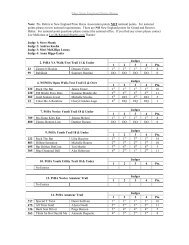2011 Official Rule Book - New England Pinto Horse Association
2011 Official Rule Book - New England Pinto Horse Association
2011 Official Rule Book - New England Pinto Horse Association
Create successful ePaper yourself
Turn your PDF publications into a flip-book with our unique Google optimized e-Paper software.
M3. Cutting<br />
A. Cutting classes shall be judged in accordance with the<br />
class rules of the National Cutting <strong>Horse</strong> <strong>Association</strong> in all<br />
areas where there are no PtHA rules applicable. All payback<br />
schedules shall follow PtHA guidelines.<br />
B. Time limit of 2-1/2 minutes per entry.<br />
C. Classes are to be judged on the ability of the <strong>Pinto</strong> to enter<br />
the herd, bring out a cow with minimum disturbance, work<br />
the cow toward the center of the arena with expression and<br />
concentration, but without malice. Once a cow is removed from<br />
the herd with light rein contact, the <strong>Pinto</strong> should work on a<br />
loose rein.<br />
D. Classes to be scored per the NCHA <strong>Rule</strong> <strong>Book</strong>. Classes are to<br />
be scored on a point basis of 60-80.<br />
M4. Judged Tie Down Roping<br />
A. Judged Tie Down Roping events will be held under the usual<br />
common rodeo standards and conditions. Entries must start<br />
from behind a barrier. Only the performance of the <strong>Pinto</strong> is to<br />
be judged. Time of the roper will not be counted for or against<br />
the entry. A time limit of one (1) minute for each entry will be<br />
allowed from the time the calf leaves the chute.<br />
B. The roper may throw only two loops. If more than one loop is<br />
thrown, the roper must recoil the rope and build the additional<br />
loop. To encourage safety, use of a second rope will not be<br />
allowed. Any catch that holds is legal, but the rope must<br />
remain on the calf until the tie is completed and the roper<br />
has mounted their horse and ridden forward, leaving slack<br />
in the rope. Once the roper has ridden forward one step and<br />
loosened the rope, the run is complete. If the calf is jerked<br />
down by the <strong>Horse</strong> or Pony, it must be allowed to regain its<br />
feet and the roper must rethrow the calf by hand, cross any<br />
three (3) feet and tie with no less than one (1) complete wrap<br />
and a half-hitch. If the calf is jerked down, over backwards,<br />
so that all four feet are in the air at the same time, this will be<br />
cause for disqualification. Failure of the calf to stay tied until<br />
the roper has remounted and ridden forward to loosen the rope<br />
shall disqualify the entry.<br />
C. A maximum of one minute or two loops, whichever comes first,<br />
will be allowed. If both loops are missed, roper will retire from<br />
arena with no score. Rope must be run through a foul rope<br />
around horse’s neck in a manner to prevent the entry from<br />
running off and dragging the calf. Dragging the calf more than<br />
ten (10) feet will result in disqualification. In Judged Tie Down<br />
Roping contests, only the roper may touch the calf while the<br />
entry is being judged. Roper may dismount from either side<br />
and leg or flank the calf.<br />
D. Optional keeper – The rope may, at the discretion of the<br />
rider, be run through a keeper. A keeper shall be described<br />
as a small loop attached to the nose band, approximately<br />
six (6) inches in length and one-half (1/2) inch in diameter,<br />
consisting of rope. If a keeper is used, it must be attached to<br />
the noseband of the tiedown and can not be attached to the bit<br />
or bridle and may not be in front of the headstall.<br />
E. Breaking the barrier, or any unnecessary whipping or spurring,<br />
jerking reins, talking, or any noise making, clapping, jerking the<br />
rope, or any unnecessary action to induce the horse to perform<br />
better, will be considered a fault and scored accordingly. If,<br />
in the opinion of the line judge, the exhibitor is fouled by any<br />
moving part of the chute, barrier, etc., ropers shall get their<br />
calf back, providing exhibitor declares himself by pulling up<br />
immediately. The exhibitor shall not attempt to rope the animal<br />
until the barrier flag has been dropped. Any attempt by an<br />
exhibitor to position his/her <strong>Pinto</strong> behind the barrier, enabling<br />
2010 PtHA <strong>Rule</strong> <strong>Book</strong> 143<br />
ClassEs



